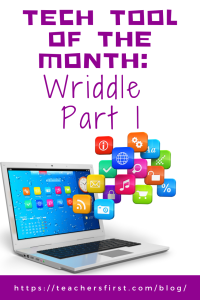Wriddle is a creative literary development tool for young learners that combines the power of writing, drawing, and speaking. Students can use the tool to draw pictures using the provided online markers and paint options, add text, and create recordings. Teachers can develop FREE accounts, including up to 150 students and five additional teacher collaborators. Students can log in using a teacher-provided link or a QR code. Finished products are printed or shared using a URL. Students’ work is automatically saved in the class/teacher portal and viewable by the teacher. Wriddle is a device-agnostic tool available on any device with a web browser or as an app for iOS and Android.
Applying the Triple E Framework
The Triple E Framework, created by Dr. Liz Kolb, states that “effective technology integration begins with good instructional strategies and not fancy tools” (tripleeframework.com). Dr. Kolb wrote a book, Learning First, Technology Second (ISTE, 2017), which lays out the three main uses of technology in education: to Engage, Enhance, or Extend learning goals. We can use this framework to decipher why we use specific classroom tools. Here is a rubric based on the Triple E Framework you can use to evaluate whether Wriddle (or any other technology) is a good fit with your learning goals and whether you should use it in your lesson.
- Engage in learning goals: The students can focus on creating their project as there are no advertisements or other distractions. Also, the students are active rather than passive learners, creating their own page with the drawing tool, plus writing and audio options.
- Enhance learning goals: Wriddle creates pathways for students to demonstrate their understanding of the learning goals in a way they cannot do without technology. Students can do the online drawing and add their voices to their stories, making this a valuable tool for even the youngest student.
- Extend learning goals: Dr. Kolb describes extended learning as an opportunity for students to learn, connect, and collaborate outside the regular school day and as a way to create a bridge between school learning and everyday life experiences. Wriddle is easy to use during a remote learning day as long as students know how to make a Wriddle and access the page. Wriddle also helps students build skills they will use in everyday life, such as using their voice and writing to demonstrate their understanding. Students also deepen their knowledge of using technology to show what they know.
SAMR Connection
The SAMR Model, by Dr. Ruben Puentedura, suggests that technology implementation has four levels. Therefore, we can use this model as a guideline to analyze how we use technology tools in the classroom. For example, Wriddle could be used at all four levels of SAMR.
- Substitution: The substitution level is the most basic level of SAMR and refers to when technology acts as a direct substitute without any functional improvements. An example of this level is using Wriddle rather than a piece of paper to draw and write your story.
- Augmentation: At the augmentation level, the technology acts as a direct substitute and includes some functional improvements. Wriddle’s classroom features allow teachers to create accounts easily (students get a direct URL or use the QR card – no email or registration is needed).
- Modification: The level of modification is when the technology allows for significant task redesign. For example, the finished story on Wriddle can be shared with the teacher or the students’ families—sharing digitally would not be possible without technology.
- Redefinition: At the redefinition level, technology allows for creating previously inconceivable new tasks. This level is achieved with Wriddle because students have the audio option that would not be possible without technology. This project is no longer just a static activity, as the students are now not just drawing a picture – they are drawing an image that will talk to the person viewing the Wriddle.
Take advantage of Part 2 of the Tech Tool of the Month: Wriddle, where we’ll discuss using the tool and classroom ideas. In the meantime, let us know how you have used Wriddle in your education setting in the comment section below.


